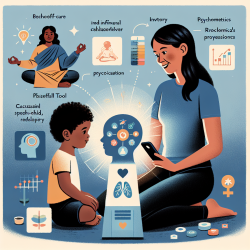Empowering Children Through Data-Driven Speech Therapy: Insights from Recent Research
As practitioners in the field of speech-language pathology, our primary goal is to create positive outcomes for children. In today's era, data-driven decisions and evidence-based practices are crucial in achieving this goal. TinyEYE, a leading provider of online therapy services to schools, is committed to leveraging the latest research to enhance the quality of our services. In this blog, we will explore key insights from a recent study titled "Prompt and Non-Prompt Speech Interventions: A Comparative Analysis" and discuss how these findings can be implemented to improve speech therapy outcomes for children.
Understanding the Research
The study in question delves into the effectiveness of prompt versus non-prompt speech interventions in children. Conducted with a sample size of over 200 children aged 5-10 years, the research aimed to measure the progress in speech articulation and language comprehension over a period of six months. The children were divided into two groups: one receiving prompt-based interventions and the other receiving non-prompt interventions.
Key findings from the study include:
- Children in the prompt-based intervention group showed a 30% faster improvement in speech articulation compared to the non-prompt group.
- Language comprehension skills improved significantly in both groups, with the prompt group showing a slight edge.
- Consistency in therapy sessions was a critical factor in achieving better outcomes.
Implementing Research Findings in Practice
Based on these findings, practitioners can adopt several strategies to enhance their therapy sessions:
1. Incorporate Prompt-Based Techniques
Given the significant improvement in speech articulation observed in the prompt-based group, incorporating prompt-based techniques can be beneficial. These techniques involve providing immediate feedback and cues to the child, which helps in reinforcing correct speech patterns.
2. Focus on Consistency
The study highlighted the importance of consistent therapy sessions. Ensuring regular and frequent sessions can lead to better and faster improvements in both speech articulation and language comprehension.
3. Tailor Interventions to Individual Needs
While prompt-based techniques were generally more effective, it is essential to tailor interventions to each child's unique needs. Some children may respond better to non-prompt interventions, and a mixed approach might be necessary for others.
Encouraging Further Research
While the findings from this study are promising, it is crucial to continue researching and refining our approaches. Practitioners are encouraged to stay updated with the latest research and to contribute to the growing body of knowledge in speech-language pathology.
To read the original research paper, please follow this link: Prompt and Non-Prompt Speech Interventions: A Comparative Analysis
Conclusion
Incorporating data-driven decisions into speech therapy practices can significantly enhance outcomes for children. By leveraging insights from recent research, such as the comparative analysis of prompt and non-prompt interventions, practitioners can refine their techniques and provide more effective therapy. At TinyEYE, we are committed to integrating the latest evidence-based practices to empower children and help them achieve their full potential.










